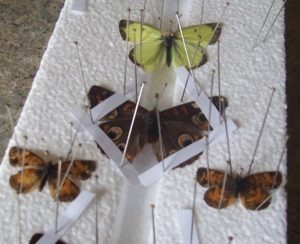 Insects are fascinating creatures. Many people are attracted to their unique appearance and vibrant colors. In fact, insect collecting has been around since the Victorian era and remains a very popular educational hobby up to the present.
Insects are fascinating creatures. Many people are attracted to their unique appearance and vibrant colors. In fact, insect collecting has been around since the Victorian era and remains a very popular educational hobby up to the present.
When properly preserved or dried, insects can be pinned and framed for display. Their hard exoskeletons do not easily deteriorate and keep the insect’s form. Dried insects are usually mounted on glass-covered boxes or frames lined with foam board on the bottom using non-corrosive pins.
Some of the most common insect collections are consisted of butterflies and beetles but any bug is appreciated by most entomology aficionados. Collections can be made of a single specimen or a group of insects.
If you are shipping dried bugs for framing or trading with other collectors, here are tips on how to properly pack and ship dried insects to ensure that they arrive intact in their destination.
Prepare a good-sized and light weight pinning boxes that can accommodate your dried insects without crowding. These boxes are usually available from craft stores and hobby shops. They usually come lined with foam board in the bottom. Make sure that the foam board is securely glued in the bottom. Otherwise, glue it and dry until set.
Measure the inner perimeter of the box and use the dimension to cut to size a piece of corrugated cardboard which will serve as an inner lid.
Stick pins vertically onto the foam board around the inner sides of the box. These pins will serve as “pillars” that will support the cardboard inner lid later on.
On one corner of the box, pin a small cotton ball. This will catch any insect part, such as a head or leg, that may get broken during transit. These parts can be glued back on the insect.
Start pinning your specimens onto the foam board. Don’t forget to include the data label for each specimen which may contain the insect’s name (if identified), date and place of capture. Only use non corrosive insect pins as ordinary pins can rust and damage the specimen.
Use additional pins to secure a long specimen and prevent it from swiveling or moving. Strips of paper attached with pins can be used to hold delicate parts in place such as wings. This way, you don’t have to pin directly on an insect’s fragile wings.
Add extra vertical support pins in empty areas of the pinning box, especially in the middle portion. Gently place the inner lid on top of the pinning box. It should rest on the heads of the vertical support pins. Fill any space between the inner lid and the pinning box lid with folded paper towel or piece of bubble wrap. Close the box and secure with tape.
Place the pinning box into a slightly larger shipping box with at least 2-inch margins on all sides, top and bottom. Use packing peanuts to fill all sides, top and bottom of the box to keep the pinning in the center.
Close the shipping box and seal with packaging tape. Address and label the package with “Fragile” and take to your local post office or shipping company.
